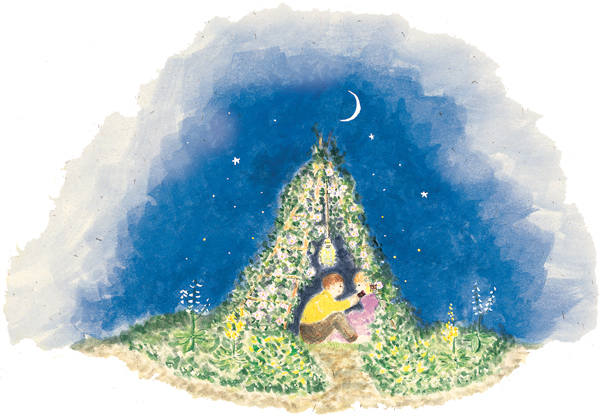
Caterpillars on a stroll hide from toads on foot patrol, and up above in buggy skies, bats take mosquitoes by surprise. Our best evening hours are spent playing in the moonflower tent. Fireflies are frequent guests; frogs stop by to eat and rest. Starry flowers lure the moths who sip and savor sugar broth.
If you think that nothing happens in your yard after dark, you’re in for a big surprise. Magic happens and miracles unfold when you plant a garden with night-blooming flowers. Under a full moon, your garden looks enchanted, glowing luminously in the night. Critters you never see in daylight stop for snacks; some stay to raise families. And you’ll be able to watch it all happening from behind the leafy walls of a vine-covered tent.
Fragrance is the color of night. When evening comes in the Moon Garden, pale flowers that look bedraggled and tired during the day lift their heads, open, and release their potent perfumes. Giant, fairylike moths slip from hiding places and follow invisible pathways of fragrance through the moonlight. Bats awaken, stretch their wings, and fly over-head in search of insects. Toads, frogs, glowworms, and fireflies become your guests. Spread out your flowery welcome mat and wait for darkness to fall.

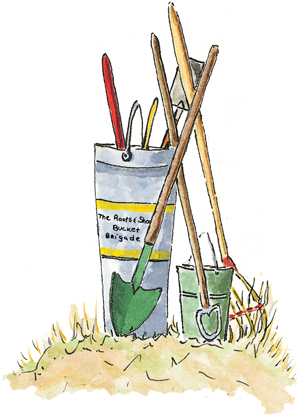
Select a flat 10-by-10-foot area that gets six hours of sun daily. Outline the area by marking it with a few handfuls of flour along its sides. One of the sides should face directly north. Stand in the center or your plot at noon on a sunny day; the shadow you cast will point north.
Using the measurements and diagram (see here) as a guide, outline a crescent moon shape with flour. Its tips should point north. (The inside arch is 14 feet long; the outside arch, is 19 feet.) Follow the outline with a hoe, digging a shallow furrow. Bisect the crescent with a pathway in the middle. Scoop out two more furrows on each side of the pathway.
To make the tent, you need at least two people. First, lay the five 6-foot poles on the ground. Tie a rope around them about 1 foot from an end. Hold the poles together, tied-end up, and raise them into an upright position in the center of the crescent.
Spread the bottom of the poles apart to make a 4-foot-wide circle. As you do this, the rope at the top tightens and stabilizes the tent. Make a doorway on the south side by widening the gap between the two legs facing the path.
To support the moonflower vines as they grow, tie a rope to the bottom of one doorway pole and weave it back and forth around the tent. As you pass each pole, wrap the rope once around it. Spiral from bottom to top, keeping the rows about 8 inches apart. Turn back when you come to the doorway and continue weaving in the opposite direction.
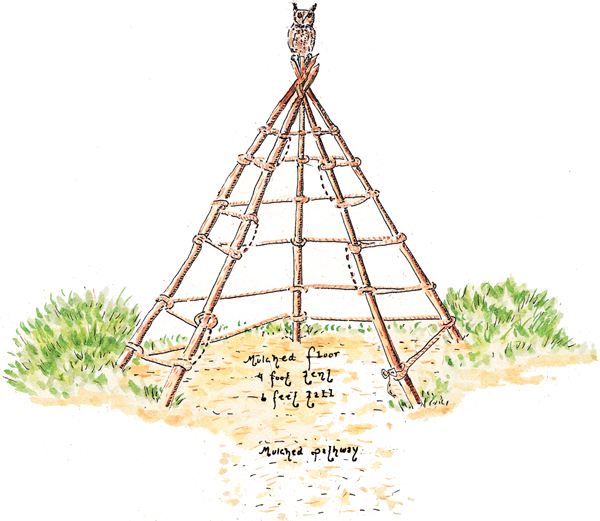

Prepare the beds of the crescent moon for planting (see Preparing the Soil). Begin planting when temperatures remain above 70°F. Place one seedling of jasmine tobacco, evening primrose, four-o’clocks, and stock in each half of the crescent. (Eight plants in all.) The planting holes should be twice the width and depth of the seedlings’ root balls. Pretreat the holes with vitamin B1 (see Planting Seedlings). Slip the seedlings gently into place, then add soil and pat it down.
In the furrows, alternate the border plants alyssum, petunia, and yarrow—spacing each seedling about 10 inches apart. (Use fourteen border plants for the inside of the crescent arch; eighteen plants for the outside arch.) Plant the remaining four border plants in the furrow along the sides of the path.
Water the plants deeply, directing the spray at the base of the plants, rather than delicate stems and leaves.
At the base of each pole, dig a hole twice the width and depth of the moonflowers’ root balls. Tuck in the moonflower seedlings, add soil, and water gently.
Mulch the seedlings with a 2-inch-deep layer of straw or shredded bark. For a soft sitting area, spread the mulch on all unplanted ground in the 10-by-10-foot plot.
Each morning, poke your finger through the mulch and into the soil to see if plants need water. Moonflowers are often thirsty, so they usually need water daily. Feed your plants once a week with a half-strength blend of liquid kelp and fish emulsion; after one month, give them a full-strength feeding every four weeks.
As the vines grow, guide them onto the poles and ropes of the tent. Stake the jasmine tobacco, if necessary.
To encourage flowers in the crescent-shaped bed to bloom more, deadhead plants by pinching or snipping the stems at the node just below the worn-out blooms.
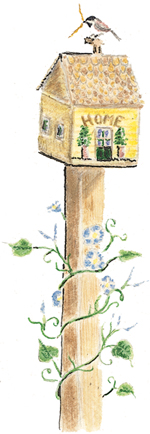


Snuggle up inside your moonflower tent and wait for the night. Close your eyes, listen to the insects tune up for their evening concert, and inhale the aromas of the opening flowers.
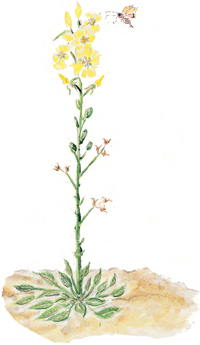
1. At dusk, watch for the evening primroses to open. First there’s a shivering movement in the swollen buds, then the pleated yellow petals pop open like satiny umbrellas.
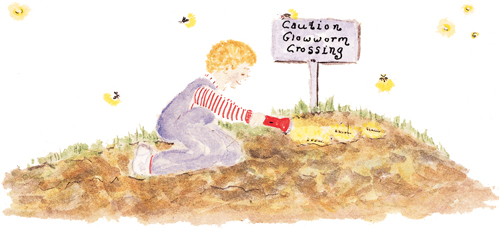
2. Tread lightly on the path, as you look for luminous firefly larvae (glowworms) crawling on the soil.
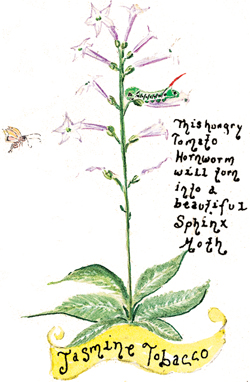
3. Do you hear the hum of sphinx moth wings? If the moths detect a pursuing bat, they dive under leaves for cover.
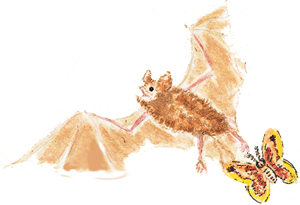
4. Bats harvest their dinners from buggy night skies. They use echo-location as well as their eyes.
5. The giant green luna looks like a fairy who was issued an oversized set of gauze wings. The luna is astonishing and looks astonished, with its two pairs of owl-like wing spots and its long trailing tail.

6. After sundown the moonflower buds begin to move imperceptibly and the white star-faced flowers open slowly to release a haunting fragrance.
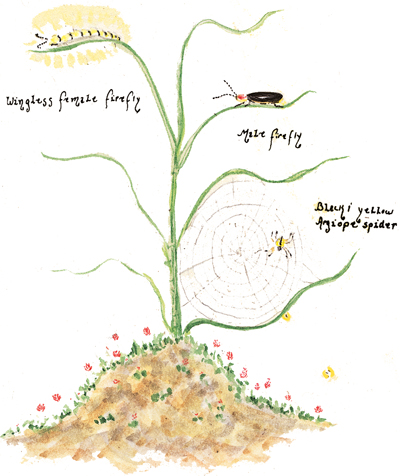
7. Watch male fireflies swoop around flashing brightly. The females stay put and fire an answering flare if they’re interested in the male.
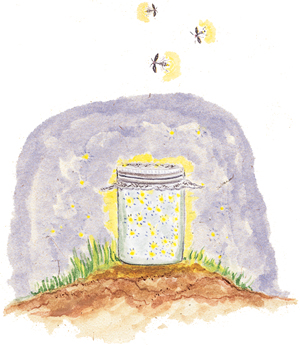
8. Use a jar with a screen lid for a firefly lantern. Catch, look, enjoy, then set the fireflies free before the night is over.
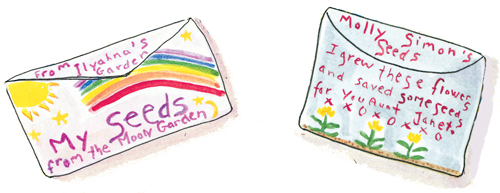
By the end of summer, a tangle of vines covers your tent and bugs and birds have staked out their territories. Stop deadheading flowers to allow the plants to set seed.
Collect the seeds spread them on a piece of paper, and let dry for a week. Then invite friends over for a seed-saving party. Label and decorate envelopes and write down the planting instructions given here. Pour the seeds into the envelopes and seal. Have friends take home four seed packs to plant their own miniature Moon Garden next spring.
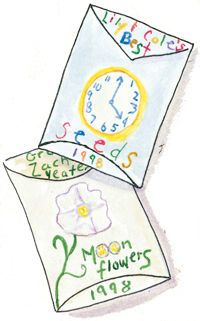
Cut the oval capsules from the plant, shake out the tiny brown seeds.
ENVELOPE INSTRUCTIONS After the temperature remains above 65°F, sow the seeds in a sunny spot with rich, freshly raked soil. Dust with more soil. When the plants are 3 inches high, thin to 18 inches apart.
Hold a paper Lag underneath the blossoms and shake the plant. Spread the seeds on a piece of paper, and let dry for a week.
ENVELOPE INSTRUCTIONS After the temperature remains above 70°F, sow the seeds ¼ inch deep in a sunny spot with rich, well-drained soil. When the plants are 3 inches high thin to 18 inches apart.
Hold a paper bag under the dried seed heads, and snip the stems so the capsules fall into the bag. Close the bag and shake.
ENVELOPE INSTRUCTIONS In late spring, sow the seeds in a sunny spot with rich, well-drained, freshly raked soil. Dust with more soil. When the plants are 3 inches high, thin to 18 inches apart.
Snip off the round capsule, break it open, and spread the seeds on a piece of paper; let dry for two weeks.
ENVELOPE INSTRUCTIONS Soak the seeds overnight in warm water before planting. After temperatures remain above 65°F, sow the seeds ¼ inch deep at the base of a trellis. The spot should have plenty of sun and rich, well-drained soil. When the plants are 3 inches high, thin to 18 inches apart.